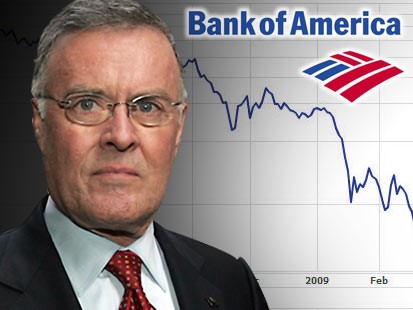Why Ken Lewis Destroyed Bank Of America
Post on: 29 Май, 2015 No Comment

In 2001 Kenneth D. Lewis became chief executive officer of Bank of America. Starting with what he called a “blank sheet of paper” listing all the companies he wanted to acquire, he proceeded to make deals for FleetBoston Financial in 2004 ($48 billion), MBNA in 2006 ($35 billion) and LaSalle Bank in 2007 ($21 billion). He was following in the footsteps of his predecessor Hugh McColl, who had undertaken a series of industry-reshaping acquisitions at NationsBank culminating in its 1998 deal for BankAmerica, as Bank of America was then called.
Now Bank of America has become a black hole. Shareholders have choked down an 80% fall in stock price since mid-September, and taxpayers are on the hook for $45 billion in cash injections and another $98 billion in backstop guarantees. How could it all have gone so wrong so fast for Lewis? Why did someone groomed to take over a great commercial bank, who was feted by American Banker magazine in 2008 as banker of the year and who was widely seen as a savior in September when he swooped in to buy Merrill Lynch, make a deal like that one for Merrill? Could anyone ever have predicted that Lewis would find himself fighting an almost certainly losing battle for his job?
Over the last 10 years I have been studying CEOs and other leaders who have made big mistakes. First in Why Smart Executives Fail. and now in my new book, Think Again: Why Good Leaders Make Bad Decisions and How to Keep It From Happening to You. I have tried to answer these questions. Why did Ken Lewis make the Merrill deal, and why did he so completely bungle it?
I believe there are two primary reasons. The first is all about emotions. Lewis had been the right-hand man to McColl, who really built Bank of America into the banking powerhouse it became. As at General Motors in the 1980s, the executives not only worked together, they practically lived together, residing in the same neighborhoods in Charlotte and belonging to the same country clubs. Even after McColl retired in 2001, he continued to be seen everywhere. He kept the offices of his investment firm on the 54th floor of Bank of America’s headquarters.
How could Lewis surpass that mighty presence? He needed to make a big splash. What could be a bigger trophy than Merrill Lynch? That’s how you can explain the single weekend of hectic due diligence, amid pressures from all sides, as the sale went through. Why would any experienced CEO who knows how to do acquisitions agree to a deal with so little information? Because he was buying a dream of a company, one that had an enormous emotional attachment for him personally. McColl had never acquired Merrill. Now Ken Lewis could do it. Wow.
The second reason why Lewis bought Merrill Lynch and destroyed his own company is all about experience–the wrong experience. If you look at earlier deals Bank of America made under both McColl and Lewis, they had two primary defining attributes: The companies acquired were all in mainstream banking, and the economy was not in severe distress. This was as true for NationsBank’s acquisition of BankAmerica as it was for Bank of America’s acquisition of FleetBoston. There was an established playbook for these takeovers: Cut overhead costs, consolidate assets, build bulk to fend off competitors and create new business opportunities.

When it came to Merrill, and also to Lewis’s takeover of Countrywide Financial earlier in 2008, for that matter, that playbook no longer applied. Countrywide was a mortgage company, not a bank, and it had potentially huge loan losses waiting to be realized. Merrill was a poster child for subprime excess and wrote the book on toxic assets. Mix in the global financial crisis–Bear Stearns and Lehman had both essentially failed by the time Bank of America agreed to acquire Merrill–and it is apparent that Lewis’ experience built up over decades of deal-making was not only off the mark, it was dangerously so. Relying on misleading experience is one of the most common explanations for bad decisions I have identified in my research. Bank of America is now Exhibit A.
What’s next for Lewis and Bank of America? It’s almost a foregone conclusion that he will be forced to resign as CEO. That’s how it plays out in virtually every instance of such self-inflicted failure. But the costs to the company will likely be considerably greater. Merrill brought brokerage and investment banking to Bank of America; Countrywide brought an expanded mortgage business. Together they made the company something akin to the financial supermarket that Citi had become. In the best of times Citi was unable to make this strategy work; now in the worst of times there is no reason to think Bank of America will do any better at it. The decade of the 2000s, the Ken Lewis decade at Bank of America, will likely end with the company’s breakup, and with the continued involvement of all of us, the taxpayers, in picking up the pieces.
Sydney Finkelstein is a professor of strategy and leadership at the Tuck School of Business at Dartmouth, and the author of Think Again: Why Good Leaders Make Bad Decisions (Harvard Business Press, 2009).














